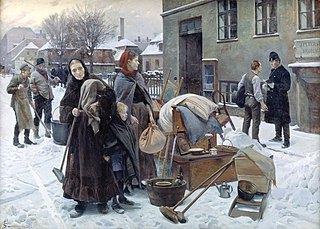 W
WDebt is an obligation that requires one party, the debtor, to pay money or other agreed-upon value to another party, the creditor. Debt is a deferred payment, or series of payments, which differentiates it from an immediate purchase. The debt may be owed by sovereign state or country, local government, company, or an individual. Commercial debt is generally subject to contractual terms regarding the amount and timing of repayments of principal and interest. Loans, bonds, notes, and mortgages are all types of debt. The term can also be used metaphorically to cover moral obligations and other interactions not based on economic value. For example, in Western cultures, a person who has been helped by a second person is sometimes said to owe a "debt of gratitude" to the second person.
 W
WA debtors' prison is a prison for people who are unable to pay debt. Through the mid-19th century, debtors' prisons were a common way to deal with unpaid debt in Western Europe. Destitute persons who were unable to pay a court-ordered judgment would be incarcerated in these prisons until they had worked off their debt via labour or secured outside funds to pay the balance. The product of their labour went towards both the costs of their incarceration and their accrued debt. Increasing access and lenience throughout the history of bankruptcy law have made prison terms for unaggravated indigence obsolete over most of the world.
 W
WEviction is the removal of a tenant from rental property by the landlord. In some jurisdictions it may also involve the removal of persons from premises that were foreclosed by a mortgagee.
 W
WForeclosure is a legal process in which a lender attempts to recover the balance of a loan from a borrower who has stopped making payments to the lender by forcing the sale of the asset used as the collateral for the loan.
 W
WA foreclosure rescue scheme is a scam that targets those whose house is facing potential foreclosure. The scheme preys on desperate homeowners whose mortgages are in default by offering to prevent the foreclosure. There are various ways in which foreclosure rescue schemes work, causing different types of harm to the homeowners, but all ultimately with the likely end result of the owner being forced out of his/her home and losing even more money.
 W
WIncome deficit is the difference between a single person or family's income and its poverty threshold or poverty line, when the former is exceeded by the latter. Data on the income deficits of various members of a population allow for the construction of one type of measurement of income inequality in that population. Individuals or families that fall below the line are considered to be in poverty whereas families that fall above are not. The income deficit is one of two measures that are used to determine a person or family's income distance from the poverty threshold, the other being a ratio rather than a difference.
 W
WA turn-off notice, cut-off notice, or shut-off notice is a warning letter sent out by the provider of a service for a residence or other building, such as utility, phone service, or cable television, that if payment is not sent by the date indicated in the notice, the service will be interrupted. Turn-off notices, which are sent after a regular bill has been sent, but may resemble a bill, are generally sent several days to weeks before the planned date, giving the customer a sufficient amount of time to make a payment that would avert the interruption.
 W
WUnderemployment is the underuse of a worker because a job does not use the worker's skills, is part-time, or leaves the worker idle. Examples include holding a part-time job despite desiring full-time work, and overqualification, in which the employee has education, experience, or skills beyond the requirements of the job.
 W
WUnemployment, according to the OECD, is persons above a specified age not being in paid employment or self-employment but currently available for work during the reference period.
 W
WYouth unemployment is the situation of young people who are looking for a job, but cannot find a job, with the age range being that defined by the United Nations as 15–24 years old. An unemployed person is defined as someone who does not have a job but is actively seeking work. In order to qualify as unemployed for official and statistical measurement, the individual must be without employment, willing and able to work, of the officially designated "working age" and actively searching for a position. Youth unemployment rates tend to be higher than the adult rates in every country in the world.